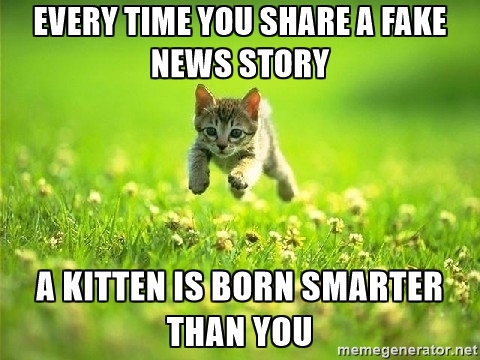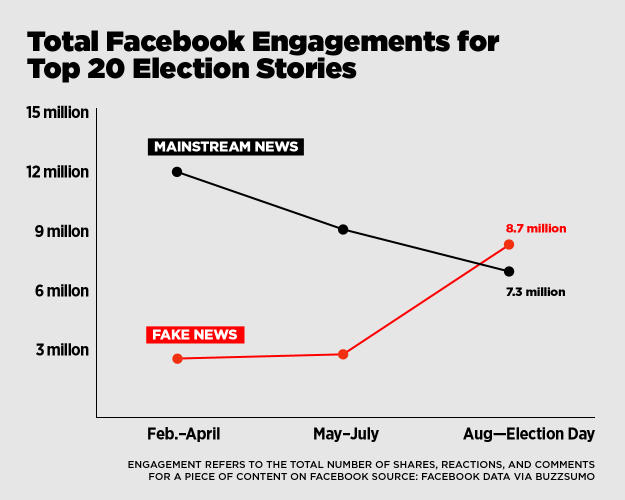We’ve all had that moment. You’re reading through a great article online, when suddenly you reach the end. Your world spins out of control as you see a promoted story titled “Your Cat May be Planning to Kill You, Here’s Why”, was everything you just read a lie? It’s difficult to trust the legitimacy of an article when you see ridiculous recommended suggestions below.
Maybe you recently saw your Aunt Sally share a “news” article about how Hillary Clinton has a body double or that Pope Francis endorsed Donald Trump. Suddenly, your news feed is full of bogus news and people you once thought were intelligent and rational, now look like fools. Fake news and deceiving web content is at an all time high and people have finally said they’ve had enough of it.
I’ll admit, I’ve on-occasion fallen for those click-bait headlines or fake news articles, only to be directed to a horrible site bogged down by hundreds of ads. Thankfully, online content is starting to get the scrutiny it needs to change and be useful to all users.
“Are Aliens Planning to Invade Earth? Find Out Now!”
Grouped together under a label like “Promoted Stories” or “Around the Web”, click-bait links lurk at the bottom of many common websites of reputable publishers. They provide high amounts of revenue to the site and give advertisers an affordable way to reach large and premium audiences. A report from ChangeAdvertising.org found that 41 of the top 50 news sites — including The Guardian, CNN, Time and Forbes — embed widgets from so-called content-recommendation companies. The deal doesn’t sound too bad, everyone is making money and happy, except for those most important, the readers.

Publishers are now considering the effect that these articles are having on their own brands. When someone reads a great article on Forbes, only to be suggested an immature or false headline, they start to think less about the legitimacy of all the content on Forbes. That is why a handful of publishers are now removing them all together, such as Slate and the New Yorker.
“It is not the right look if you’re trying to say you’re a high-quality, upper-tier website — if you have something like this on it — and I think it’s time for us to be honest about that,” said Keith Hernandez, Slate’s president.

There is still a lot of progress to be made for a lot of publishers, but the fact that some are listening to the concerns of consumers and taking action is a step in the right direction.
“Obama Bans Pledge of Allegiance in Schools Nationwide”
What’s worse than seeing click bait headlines suggested by robots at the bottom of articles? Seeing fake cringe-worthy articles suggested by your friends and family on Facebook. According to the Business Insider, 2.2 million people engaged with the Obama article with the headline mentioned above. That’s 2.2 million people who believed that the President signed an executive order banning the Pledge of Allegiance.
Unfortunately, this wasn’t the only article that hooked people in, by the time of the election, fake stories had more engagements than real news stories. The chart below shows the engagement for fake and real news stories over the past year. As you can see, the two months leading up to the election actually had more fake news engagements than real news engagements on Facebook. This should scare any logical person.
The stories are most often put together by scammers trying to make a quick buck. Every time someone falls for the fake headline and clicks through, the site gets money from advertisers. Fake news has always been around, but the use of social media and a politically divided nation created to perfect atmosphere for publishers to cash in on the gullible. Some critics have even expressed concern (but haven’t proven) that fake news helped sway the election, as many people were blinded by fake information heading into the polls.
What’s Next?
Fortunately, the problem escalated to a high enough degree that people are demanding that things change soon. Google has announced that its advertising tools will no longer be available to websites that promoted fake news. “Moving forward, we will restrict ads serving on pages that misrepresent, misstate, or conceal information about the publisher, the publisher’s content, or the primary purpose of the web property,” a Google spokesperson said in a recent statement. This move will vastly impact the ad revenue these sites can earn, and will hopefully lessen the amount of stories and sites created.
Facebook, who is under a lot of public scrutiny for allowing so much fake news to flood the platform, announced that it will also remove ads on fake news sites. In addition, Zuckerberg outlined different ways Facebook hopes to eliminate misinformation on the site including:
- Stronger detection measures
- Easy reporting of fake stories by users
- Third party verification by fact-checking organizations
- Adding warnings or flagging false stories by third parties or the Facebook community
Nothing is set in stone yet, but the anger of the public and critics should be motivation for solutions to be implemented quickly.
Make it Stop
There is also one other party that can help stop the spread of fake news, and that’s you. Although its no user’s sole responsibility to fact-check every news story in their social feed, you can mark fake stories as spam. Staying aware and doing a minute of research before sharing an article can save you from looking silly to your friends and family and will help combat the problem of fake news.
If you’re an advertiser, you can vote with your dollars and only show ads on real news sites. Let’s all work together and take down the crappy content lurking on our beloved internet.

